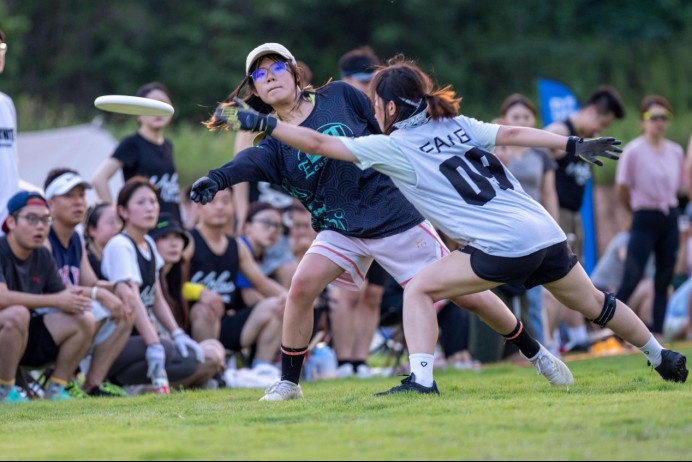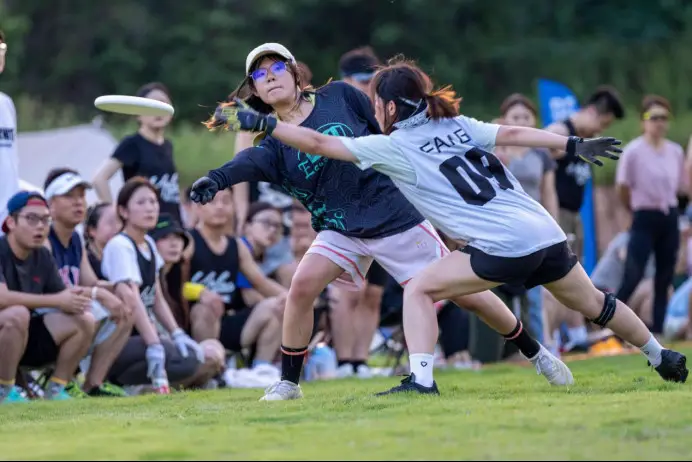Fan Jiayuan, People's Daily

Frisbee enthusiasts compete in a match held in Changlinhe town, Feidong county, Hefei city, east China's Anhui Province, on July 30, 2022. (Photo by Ruan Xuefeng/People's Daily Online)
In recent years, China's sports industry has achieved remarkable progress as domestic fitness consumption has seen robust growth and homegrown sports brands have gained popularity among consumers.
At the recently concluded 2022 China International Fair for Trade in Services (CIFTIS), the 20,000-square-meter sports services exhibition attracted 353 enterprises and organizations participating in the event online or offline. Sports service deals worth a record high of about 12.72 billion yuan (around $1.77 billion) were signed at the exhibition.
It proves that China's sports industry is growing vigorously.
China made the "Fitness for All" program a national strategy in 2014, steering the course for the development of the sports industry.
For years, China's sports industry has maintained rapid growth and its industrial structure has been continually optimized. A sports industry system driven by sports games, performances, fitness and sports-related leisure activities has been basically formed, with synergistic development of sports manufacturing and the media.
For example, according to statistics from the Chinese Athletics Association (CAA), China held 1,828 marathon-related events in 2019, which was 47 times as many as in 2013.
The country has also released development plans for other popular sports, encouraging social forces to organize sports activities while encouraging public engagement in sports, thus pushing forward the development of fitness and sports-related leisure activities.
Today, Chinese citizens have diverse choices in sports activities. Outdoor sports activities, including mountaineering and cycling, see burgeoning growth. Traditional sports such as football, basketball, badminton and swimming enjoy continuous popularity, and niche sports, including frisbee and paddle boarding, are widely participated.
The Beijing 2022 Winter Olympics and Paralympic Games have driven the development of winter sports in China. According to Peng Weiyong, vice-director of the General Administration of Sport of China (GAS), China's snow-related sports saw 312 million visits in the 2021-2022 winter season. The period also achieved a snow tourism revenue of 390 billion yuan, an increase of 44.4 percent from the 2016-2017 winter season.
As the mass fitness program is being increasingly accepted by the general public, buying sports equipment, taking part in sports training, experiencing sports fashion, watching sports events and hiring sports venues have become new scenarios of sports consumption.
Statistics from the GAS indicated that the size of China's fitness and sports-related leisure grew from 27.69 billion yuan to 179.66 billion yuan, an increase of 548.83 percent.
China's winter sports equipment manufacturing has also embarked on a fast lane of development after the Beijing 2022 Winter Olympic Games. Provinces in northeast China have rolled out plans for the construction of winter sports equipment industrial parks while ramping up investment in the related market.
Driven by the mass fitness program and favorable policies, China's homegrown sports brands have taken coordinated efforts to strive for sci-tech innovations, reform of sales channels and expansion of their global influence.
During the 13th Five-Year Plan period (2016-2020), the number of market entities in China's sports market kept increasing. By the end of 2019, China had 289,000 legal entities in the sports market, an increase of 150 percent from 2015.
Many time-honored homegrown sports brands unveiled their performance recently in the first half of 2022. Anta Sports, one of China's largest sportswear companies, registered revenue of nearly 26 billion yuan in the first half of the year, up 13.8 percent year on year.
Zhangjiakou JX Sports, a new sports company founded in 2018 in Zhangjiakou city, north China's Hebei Province, mainly produces snowboards, sleds for Alpine skiing, sleds for cross-country skiing and fixation devices. The rising star has maintained an annual sales growth between 15 percent and 20 percent.
China's sports industry has entered a crucial stage of development during the 14th Five-Year Plan period (2021-2025).
Last October, the country issued a development plan for the sports industry throughout the period, which sets a long-term goal of building the country into a leading sporting power by 2035 and outlined main targets that cover eight aspects, including raising the level of mass fitness and achieving new progress in the development of the sports industry.
Looking ahead, the country's sports industry will push for further integration with other industries and actively explore ways to lead a healthy lifestyle, expand domestic demand, and boost consumption as the sector sees significant increases in size and enjoys a better development environment and greater market potential.
At the recently concluded 2022 China International Fair for Trade in Services (CIFTIS), the 20,000-square-meter sports services exhibition attracted 353 enterprises and organizations participating in the event online or offline. Sports service deals worth a record high of about 12.72 billion yuan (around $1.77 billion) were signed at the exhibition.
It proves that China's sports industry is growing vigorously.
China made the "Fitness for All" program a national strategy in 2014, steering the course for the development of the sports industry.
For years, China's sports industry has maintained rapid growth and its industrial structure has been continually optimized. A sports industry system driven by sports games, performances, fitness and sports-related leisure activities has been basically formed, with synergistic development of sports manufacturing and the media.
For example, according to statistics from the Chinese Athletics Association (CAA), China held 1,828 marathon-related events in 2019, which was 47 times as many as in 2013.
The country has also released development plans for other popular sports, encouraging social forces to organize sports activities while encouraging public engagement in sports, thus pushing forward the development of fitness and sports-related leisure activities.
Today, Chinese citizens have diverse choices in sports activities. Outdoor sports activities, including mountaineering and cycling, see burgeoning growth. Traditional sports such as football, basketball, badminton and swimming enjoy continuous popularity, and niche sports, including frisbee and paddle boarding, are widely participated.
The Beijing 2022 Winter Olympics and Paralympic Games have driven the development of winter sports in China. According to Peng Weiyong, vice-director of the General Administration of Sport of China (GAS), China's snow-related sports saw 312 million visits in the 2021-2022 winter season. The period also achieved a snow tourism revenue of 390 billion yuan, an increase of 44.4 percent from the 2016-2017 winter season.
As the mass fitness program is being increasingly accepted by the general public, buying sports equipment, taking part in sports training, experiencing sports fashion, watching sports events and hiring sports venues have become new scenarios of sports consumption.
Statistics from the GAS indicated that the size of China's fitness and sports-related leisure grew from 27.69 billion yuan to 179.66 billion yuan, an increase of 548.83 percent.
China's winter sports equipment manufacturing has also embarked on a fast lane of development after the Beijing 2022 Winter Olympic Games. Provinces in northeast China have rolled out plans for the construction of winter sports equipment industrial parks while ramping up investment in the related market.
Driven by the mass fitness program and favorable policies, China's homegrown sports brands have taken coordinated efforts to strive for sci-tech innovations, reform of sales channels and expansion of their global influence.
During the 13th Five-Year Plan period (2016-2020), the number of market entities in China's sports market kept increasing. By the end of 2019, China had 289,000 legal entities in the sports market, an increase of 150 percent from 2015.
Many time-honored homegrown sports brands unveiled their performance recently in the first half of 2022. Anta Sports, one of China's largest sportswear companies, registered revenue of nearly 26 billion yuan in the first half of the year, up 13.8 percent year on year.
Zhangjiakou JX Sports, a new sports company founded in 2018 in Zhangjiakou city, north China's Hebei Province, mainly produces snowboards, sleds for Alpine skiing, sleds for cross-country skiing and fixation devices. The rising star has maintained an annual sales growth between 15 percent and 20 percent.
China's sports industry has entered a crucial stage of development during the 14th Five-Year Plan period (2021-2025).
Last October, the country issued a development plan for the sports industry throughout the period, which sets a long-term goal of building the country into a leading sporting power by 2035 and outlined main targets that cover eight aspects, including raising the level of mass fitness and achieving new progress in the development of the sports industry.
Looking ahead, the country's sports industry will push for further integration with other industries and actively explore ways to lead a healthy lifestyle, expand domestic demand, and boost consumption as the sector sees significant increases in size and enjoys a better development environment and greater market potential.
 Menu
Menu
 China's sports industry on fast track of development
China's sports industry on fast track of development
















